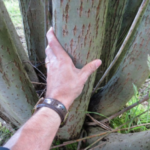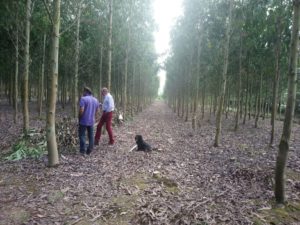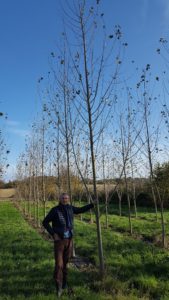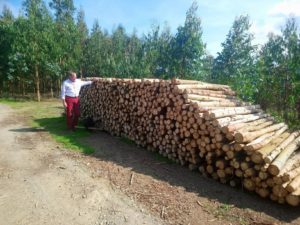Want to grow your own firewood? Take a look at these high yielding options
Do you have a bit of land and a wood stove or log boiler? If so, you should consider planting some fast growing trees to produce ample quantities of fuel in no time.
If you do a search online for the best trees for logs you’ll find the same list reproduced again and again. A long, long time ago someone spent some effort developing this directory and it’s been repeated and plagiarised without mercy. So often in fact, that it now believed to be undeniably true. I’m no conspiracy theorist – overall I agree with a lot of the information. However, there is also a great deal of received wisdom and some spurious misinformation about the lack of virtue of some woods. In particular, willow, poplar and eucalyptus come way down the league table of desirable woodfuels – described as too wet, too fast burning, putrid smell, tough to split etc. etc.
If you believe what you read you are going to be put right off and either decide to plant some hardwoods or continue to buy from your local log merchant. Either of these options has real downsides. With the former, you need to ask yourself whether you have 20 years to wait for oak, ash or hornbeam to grow and produce decent logs? They are fantastic trees but they have dense wood for a reason – because they are slow growing.
If you continue to buy in logs, you will almost certainly be aware of the rise in prices in recent months and years. Everyone and their dog has a log stove these days, there are 20,000 plus biomass boilers in the UK and lots of power stations all competing for cheap sources of wood. Demand is outstripping supply.
So if you have a bit of land and want firewood quickly then you would be foolish to overlook short rotation trees. Here’s my alternative guide to the grow your own firewood runners and riders (well the ones we sell anyway!):
Willow

The Usain Bolt of trees – willow is the quickest tree out of the blocks! Incredible high yield biomass growth in just 4 years.
Let’s look at the pros first – easy to grow, cheap planting stock, very fast growing, excellent yield and good form. You can produce log scale willow in just 4 years. Most of our biomass varieties are excellent coppicing but there are some that can be encouraged to grow as a single stem from a 2 metre sett.
Yet, willow comes in for all sorts of criticism. I have lost count of the number of people who say that they wouldn’t waste their time with this fuel. Their reasons are:
- “Wet wood that takes ages to season” – The first half of this statement is correct. Willow wood is on average 55% moisture content when harvested. However the latter view is completely wrong. Unlike oak which takes two years to season willow logs can be ready to burn in three months. Take my word for it you can almost watch it dry! Put in on bearers under cover with a nice breeze circulating through it and you’ll see the cracks appearing almost immediately. Willow is probably the quickest drying wood. Period!
- “It’s light, burns quickly, doesn’t produce much heat and has a poor flame” – Again the first half of these points are correct to some extent. It is light – the looseness of wood fibre is the reason it dries so quickly. However, there is variation in the genus – white willow (Salix

Willow logs in my stove. Believe me they were pumping out the heat. Pleasing flame too – what’s not to like?
alba) is very light (that’s why cricket bats are made of it!) whilst goat willow (Salix caprea) is a much harder grained willow – this will take up less space and burn longer. The criticism about heat output and poor flame is simply not true. I use all sorts of willow on my stove and honestly can report that I am delighted by both. I tend to use willow along with some pine, some hardwoods and some briquettes. It’s a really good combination as the willow and pine get the fire going quickly and helps the hard woods and briquettes ignite so they don’t slumber and produce smoke.
If you are happy to accept the limitations then I think you’ll be pleasantly surprised by willow logs. See the price list for willow rods, setts and cuttings here.
Poplar
Most poplars we sell are perfect for single stem production. Over 5-8 years you’ll end up with some very sizable logs that are easy to harvest. At this point you can allow to coppice or spray off and replant.
The oft said criticism of poplar is that it burns with a putrid smell. This is simply not the case if you season your poplar logs under cover and off the ground. If you use wet poplar with its bark on then yes it is likely to be smelly but why would you want to do this? Follow best practice and you’ll have a wood with similar properties to willow. Leave it out in the elements and poplar and willow will soak up water like a sponge. One of the largest kiln drying log producers is Certainly Wood – all of their logs are poplar so go figure!
See the price list for poplar rods, setts and cuttings here.
Eucalyptus

Thinning operation carried out at the award winning Treworder site in Cornwall. The Eucalyptus nitens plantation was just over 4 years old and the trees are 12m in height already!
Eucalyptus have a much higher density than willow or poplar so these will produce longer burning logs and complement the other species well. Plant at 1667 per hectare and after 4 years you’ll be able to thin out with a good harvest. After 8 years you’ll be able to fell the rest and have an excellent log resource on your hands. Some Eucs can coppice well so you can allow them to grow back or spray off and restock.
The biggest problem that people state about Eucs is that they are difficult to split. Like the example with willow this is perhaps another case of tarring all with the same brush. It’s true that some species will be a bit stringy for instance Eucalyptus gunnii which can be quite a wild, sprawling tree with unpredictable grain. Most eucalyptus species and provenances that we sell have excellent form and there should be no problem whatsoever splitting them.
See the price list for Eucalyptus plug plants here.
So all in all I would urge you to disregard the information about these tree species that you will find reproduced on stove seller’s websites all over the world. Have a go with willow, poplar and eucalyptus – I really do think you’ll be very pleasantly surprised not only by their yields and quality of the firewood but also by the savings you’ll make against bought in firewood. The other key thing to remember about short rotation trees is that this land use change is reversible. Any tree that has a rotation less than 20 years is not classified as forestry. So, if you change your mind in the years ahead you can restore the land to agriculture.
It’s not too late to order for 2019 but be quick!
Want to know how to use your wood burning stove correctly? We recommend the following book: The Log Book: Getting The Best From Your Woodburning Stove by Will Rolls. Buy it here.

